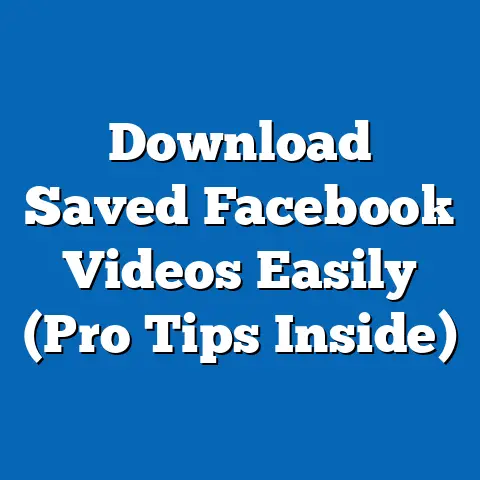Discover New Friends (Pro Tips for Facebook Users)
In today’s hyper-connected world, social media platforms like Facebook have become central hubs for communication, information sharing, and, most importantly, building relationships. We often underestimate the power of a first impression, especially in the digital realm. Think about it: your Facebook profile is often the first glimpse someone gets of who you are. It’s your digital handshake. How you present yourself online can significantly impact your ability to connect with others, foster friendships, and build a supportive network. A sloppy profile, a lack of engagement, or a closed-off demeanor can all hinder your chances of making genuine connections. On the other hand, a well-crafted profile, thoughtful interactions, and a genuine interest in others can open doors to a world of new friendships and opportunities.
I’ve personally experienced the power of online connections. Years ago, I joined a Facebook group dedicated to photography. Through sharing my photos, providing feedback, and engaging in discussions, I not only improved my skills but also forged lasting friendships with people from all over the world. These connections have led to collaborations, travel opportunities, and a constant source of inspiration. This article aims to equip you with the pro tips you need to make a positive and engaging first impression on Facebook, paving the way for meaningful friendships and connections.
Crafting an Engaging Profile
Your Facebook profile is your digital storefront, and like any good storefront, it needs to be inviting and representative of what you offer. It’s more than just a place to list your name and basic information; it’s an opportunity to showcase your personality, interests, and values. Think of it as your personal brand. Here’s how to make sure your profile is making the right impression:
Profile Picture: A Picture is Worth a Thousand Friendships
Your profile picture is often the first thing people see, so it’s crucial to choose wisely. Ditch the blurry selfies and opt for a high-quality image that clearly shows your face. A smiling face is generally more approachable and inviting than a serious or brooding one. Aim for authenticity. Choose a photo that reflects your personality and makes you feel confident. I always advise clients to avoid using group photos as profile pictures, as it can be confusing for people to identify you. Also, make sure the photo is up-to-date. A picture from ten years ago might not accurately represent who you are today.
Takeaway: Use a high-quality, recent photo that clearly shows your smiling face.
Cover Photo: Tell Your Story Visually
While your profile picture is a snapshot, your cover photo is an opportunity to tell a story. Choose an image that represents your interests, passions, or values. It could be a photo of you engaging in a hobby, a scenic landscape from your travels, or an image that reflects your profession. I once worked with a freelance graphic designer who used her cover photo to showcase a collage of her best work. It immediately conveyed her skills and expertise, attracting potential clients and collaborators. The key is to choose something visually appealing that sparks curiosity and gives people a glimpse into your world.
Takeaway: Use your cover photo to showcase your interests, passions, or profession.
Bio Section: A Concise Introduction
Your bio section is your chance to introduce yourself in a few concise sentences. Think of it as your elevator pitch. Highlight your key interests, hobbies, and personality traits. Be specific and avoid generic phrases like “I love to travel” or “I’m a foodie.” Instead, try something like “Avid hiker exploring the Pacific Northwest” or “Passionate home cook experimenting with Thai cuisine.” I often recommend including a call to action, such as “Connect with me if you’re interested in [your interest]” or “Follow my adventures on [your blog/social media].” This encourages people to engage with you and learn more about you.
Takeaway: Craft a concise and informative bio that highlights your key interests and includes a call to action.
Links to Other Social Media: Extend Your Reach
Including links to your other social media accounts or personal website is a great way to provide people with a more comprehensive view of who you are. It allows them to explore your interests and passions in greater detail and connect with you on other platforms. If you’re a photographer, link to your Instagram account. If you’re a writer, link to your blog. This not only expands your reach but also helps you build a stronger online presence.
Takeaway: Include links to your other social media accounts or personal website to provide a more comprehensive view of who you are.
By carefully crafting your profile, you’re setting the stage for positive interactions and meaningful connections. Remember, your profile is your digital handshake, so make it a good one!
Utilizing Facebook Groups and Pages
Facebook groups and pages are fertile ground for meeting new people who share your interests and passions. These communities provide a platform for engaging in discussions, sharing insights, and building relationships around common interests. However, simply joining a group isn’t enough. You need to be proactive and engage with other members to forge meaningful connections.
Finding the Right Groups: Alignment is Key
The first step is to identify groups that align with your personal hobbies, professional interests, or values. Use Facebook’s search function to find groups related to your interests. For example, if you’re a book lover, search for “book clubs,” “reading groups,” or “literary societies.” If you’re a marketing professional, search for “digital marketing,” “social media marketing,” or “content marketing.” The more specific you are, the more likely you are to find groups that are a good fit for you. I often recommend joining a variety of groups, from large, general interest groups to smaller, niche groups. This allows you to explore different communities and find the ones where you feel most comfortable and engaged.
Takeaway: Search for groups that align with your personal hobbies, professional interests, or values.
Participating in Discussions: Share Your Insights
Once you’ve joined a group, the next step is to participate in discussions. Don’t just lurk in the background; actively engage with other members by asking questions, sharing insights, and providing helpful advice. Respond to posts that resonate with you and offer your perspective. The more you contribute to the community, the more visible you’ll become and the more likely you are to attract new friends. I’ve found that asking open-ended questions is a great way to spark conversations and encourage engagement. For example, instead of asking “Did you like this book?”, try asking “What did you think of the ending of this book and how did it make you feel?”.
Takeaway: Actively participate in discussions by asking questions, sharing insights, and providing helpful advice.
Initiating Conversations: Break the Ice
Don’t be afraid to initiate conversations with other group members. If you see someone post something interesting, reach out to them and start a dialogue. You can comment on their post, send them a private message, or even tag them in a relevant post. The key is to be friendly, respectful, and genuine. Start by complimenting their post or asking a follow-up question. Avoid being overly promotional or self-serving. The goal is to build a relationship, not to sell something. I’ve found that sharing personal stories or experiences related to the topic at hand is a great way to connect with others on a deeper level.
Takeaway: Initiate conversations with other group members by commenting on their posts, sending them private messages, or tagging them in relevant content.
Engaging with Pages: Show Your Support
Similar to groups, Facebook pages dedicated to specific interests or causes can also be a great way to connect with like-minded individuals. By liking and following relevant pages, you’ll gain access to a wealth of information, resources, and opportunities for engagement. Engage with the content posted on these pages by liking, commenting, and sharing posts that resonate with you. This will not only show your support for the page but also increase your visibility and attract new friends.
Takeaway: Engage with content posted on Facebook pages by liking, commenting, and sharing posts that resonate with you.
By actively participating in Facebook groups and engaging with relevant pages, you can expand your network, connect with like-minded individuals, and build meaningful friendships around shared interests. Remember, the key is to be proactive, genuine, and respectful in your interactions.
Engaging with Content
Content engagement is the lifeblood of Facebook. It’s how you connect with others, express your opinions, and build relationships. The more you engage with content, the more visible you’ll become and the more likely you are to attract new friends. However, simply liking every post you see isn’t enough. You need to be thoughtful and intentional in your engagement to make a meaningful impact.
Liking, Commenting, and Sharing: Amplify Your Voice
Liking, commenting, and sharing posts are the basic building blocks of content engagement. Liking a post is a quick and easy way to show your appreciation and support. Commenting on a post allows you to express your opinion, ask questions, or share your own insights. Sharing a post allows you to amplify its reach and introduce it to your own network. I often recommend using a combination of these three actions to maximize your impact. For example, if you see a post that you like, take a moment to write a thoughtful comment and then share it with your network.
Takeaway: Use a combination of liking, commenting, and sharing posts to maximize your impact.
Creating Meaningful Interactions: Add Value to the Conversation
The key to effective content engagement is to create meaningful interactions. Don’t just leave generic comments like “Great post!” or “Interesting.” Instead, try to add value to the conversation by sharing your own experiences, offering helpful advice, or asking thought-provoking questions. I’ve found that asking open-ended questions is a great way to encourage further discussion and build rapport with other users. For example, instead of saying “I agree,” try saying “I agree, and I think this is especially relevant because [your reason].”
Takeaway: Create meaningful interactions by sharing your own experiences, offering helpful advice, or asking thought-provoking questions.
Being Genuine and Respectful: Build Trust and Rapport
When engaging with content, it’s crucial to be genuine and respectful. Avoid being argumentative, confrontational, or disrespectful. Even if you disagree with someone’s opinion, express your disagreement in a polite and constructive manner. Remember, the goal is to build relationships, not to win arguments. I always advise clients to avoid engaging in political or controversial topics unless they are comfortable with the potential for heated debates.
Takeaway: Be genuine and respectful in your interactions, even when you disagree with someone’s opinion.
Sharing Personal Stories: Connect on a Deeper Level
Sharing personal stories related to the content is a powerful way to connect with others on a deeper level. It allows you to reveal your personality, share your experiences, and build trust with your audience. For example, if you see a post about overcoming challenges, share your own story of resilience and how you overcame a similar obstacle. This will not only inspire others but also make you more relatable and approachable.
Takeaway: Share personal stories related to the content to connect with others on a deeper level.
By engaging with content in a thoughtful, genuine, and respectful manner, you can build trust, establish rapport, and attract new friends who share your values and interests. Remember, the key is to be yourself and to add value to the conversation.
Sending Friend Requests and Messages
Sending friend requests and messages is a direct way to connect with new acquaintances and initiate friendships. However, it’s important to approach this process with care and consideration. Sending a generic friend request without any context can be off-putting, and sending unsolicited messages can be perceived as spammy or intrusive.
Personalized Friend Requests: Make a Connection
When sending friend requests to new acquaintances, always include a personalized message to introduce yourself and explain why you’re reaching out. This shows that you’ve taken the time to learn about them and that you’re genuinely interested in connecting. Avoid sending generic friend requests with the default message “I’d like to add you as a friend.” Instead, try something like “Hi [Name], I saw your post in [Group Name] about [Topic] and I found it really insightful. I’d love to connect with you and learn more about your work.”
Takeaway: Always include a personalized message when sending friend requests to new acquaintances.
Crafting Friendly Messages: Start a Conversation
When reaching out to new friends via private message, craft a friendly and open message that invites conversation. Start by introducing yourself and explaining how you found them. Then, ask a question or share a thought related to their interests or expertise. Avoid being overly aggressive or salesy. The goal is to start a conversation, not to pitch your product or service. I often recommend starting with a compliment or a shared interest. For example, “Hi [Name], I really enjoyed your presentation at [Conference Name]. I’m also working on [Similar Project] and I’d love to hear your thoughts on [Specific Aspect].”
Takeaway: Craft a friendly and open message that invites conversation and avoids being overly aggressive or salesy.
Being Patient and Respectful: Give Space and Time
Not everyone will respond to your friend requests or messages immediately. Some people are busy, while others may be hesitant to connect with strangers online. Be patient and respectful, and don’t take it personally if someone doesn’t respond. Give them space and time to consider your request, and avoid sending follow-up messages unless they’ve indicated that they’re interested in connecting. I always advise clients to avoid sending more than one follow-up message, as it can be perceived as harassing.
Takeaway: Be patient and respectful if someone doesn’t respond to your friend requests or messages immediately.
Avoiding Spammy Behavior: Build Genuine Connections
Avoid sending mass friend requests or unsolicited messages to large groups of people. This is considered spammy behavior and can damage your reputation. Instead, focus on building genuine connections with people who share your interests and values. Take the time to learn about them, engage with their content, and build a relationship before sending a friend request or message.
Takeaway: Avoid sending mass friend requests or unsolicited messages to large groups of people.
By approaching friend requests and messages with care, consideration, and respect, you can increase your chances of connecting with new acquaintances and building meaningful friendships on Facebook. Remember, the key is to be genuine, patient, and respectful in your interactions.
Maintaining Connections
Building a friendship is only half the battle. Maintaining that friendship requires ongoing effort and attention. Like any relationship, friendships on Facebook need to be nurtured and cultivated to thrive. Regular communication, shared experiences, and genuine interest in each other’s lives are essential for keeping the bond strong.
Regular Communication: Stay in Touch
One of the most important aspects of maintaining connections is regular communication. Use Facebook’s messaging feature to stay in touch with your new friends. Send them occasional messages to check in, share updates on your life, or simply say hello. Comment on their posts, like their photos, and share their content to show that you’re engaged with their lives. I often recommend setting a reminder to reach out to your new friends on a regular basis, whether it’s weekly, monthly, or quarterly.
Takeaway: Use Facebook’s messaging feature to stay in touch with your new friends and comment on their posts to show that you’re engaged with their lives.
Using Facebook Features: Explore the Possibilities
Facebook offers a variety of features that can help you stay connected with your friends. Use events to invite them to parties, gatherings, or online webinars. Create groups to discuss shared interests, collaborate on projects, or simply chat about life. Use Messenger to send quick messages, share photos, or video chat with your friends. I’ve found that creating a group for a specific project or interest is a great way to foster collaboration and build a stronger sense of community.
Takeaway: Use Facebook’s events, groups, and Messenger features to stay connected with your friends and foster collaboration.
Celebrating Milestones: Show Your Support
Take the time to celebrate your new friends’ milestones and achievements. Comment on their posts congratulating them on a new job, a birthday, or a personal accomplishment. Send them a private message to offer your support or encouragement during difficult times. Small gestures like these can go a long way in strengthening your bond and showing that you care. I often recommend setting a reminder to wish your friends a happy birthday or to congratulate them on a new achievement.
Takeaway: Celebrate your new friends’ milestones and achievements by commenting on their posts or sending them private messages.
Planning Meetups: Take it Offline
While online connections are valuable, nothing beats the experience of meeting your friends in person. Plan meetups or virtual hangouts to take your friendships offline and build a stronger connection. If you live in the same city, suggest grabbing coffee, going to a concert, or attending a local event together. If you live far apart, schedule a video call or plan a virtual game night. I’ve found that meeting my online friends in person has deepened our friendships and created lasting memories.
Takeaway: Plan meetups or virtual hangouts to take your friendships offline and build a stronger connection.
By making an effort to maintain your connections, you can transform your Facebook friendships into lasting and meaningful relationships. Remember, the key is to be consistent, genuine, and engaged in your interactions.
Conclusion
In today’s digital age, Facebook offers a powerful platform for discovering and building new friendships. By crafting an engaging profile, utilizing Facebook groups and pages, engaging with content, sending thoughtful friend requests and messages, and maintaining connections, you can unlock the potential of this social media giant to create lasting and meaningful relationships. Remember, first impressions matter, so take the time to present yourself in an authentic and engaging way. Be proactive in your interactions, participate in discussions, and show genuine interest in others. Don’t be afraid to reach out and initiate conversations. And most importantly, be patient and respectful, allowing friendships to develop organically.
The world of online connections is vast and full of possibilities. Embrace the opportunity to connect with like-minded individuals, share your passions, and build a supportive network of friends. By following these pro tips, you can transform your Facebook experience from a passive pastime to a vibrant and fulfilling social life. So go ahead, start connecting, and discover the joy of building new friendships on Facebook!






